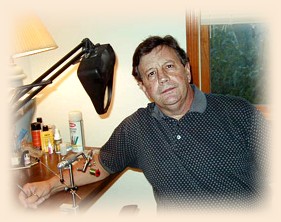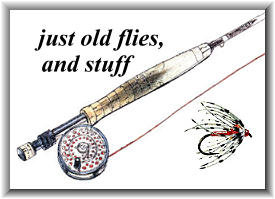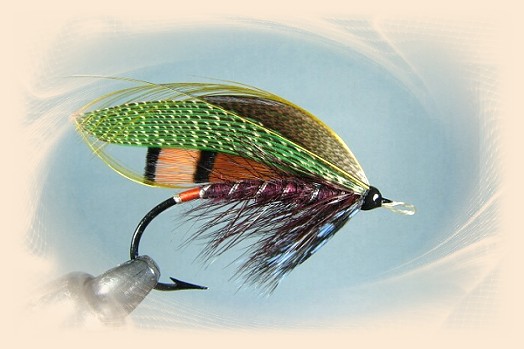I've been really struggling with a few things lately. I would
mount a wing on a full dress fly, and it would look great to
me, but by the time it was done I had no more "hump" in
the wing, which was in some cases, bitterly disappointing.
I knew how I wanted things to look, but was just not
achieving the results I thought I should be getting. I did various
things to try to get back to where I thought I should be, with
mixed success. Finally, in desperation, I turned to Dave Carne,
a tier of classics for whom I have great respect. Within a couple
of emails back and forth we had agreed on the source of the
problem, which turned out to be the topping pushing the wing
down and out of shape. Dave had a solution for manipulating
the shape of the topping which he called his "patented topping
fitting technique." Sure enough, problem solved. The lesson
here is this: Regardless of how long one has tied, or how much
one thinks he knows, there is always someone who can help
if you get into one of these funks. Don't suffer in silence as I've
done for the last month, wondering what the problem is, ask
somebody. You will be amazed at how many tiers are willing
to help, no matter who they are. Three that come to mind right
now, tiers who are in that top tier of the pantheon of fly dressers
are Hans Weilenmann, Alice Conba, and Charley Craven. Each
of these fantastic tiers give of themselves on a regular basis, and I
would venture to say that each one of them have helped dozens if
not hundreds of tiers learn techniques and helped countless others
through the rough patches. All you have to do is ask.
Now that I have today's lesson out of the way, on to the Halifax.
There is not an abundance of information available through my
sources concerning this fly, but we can make some educated
guesses about it. First off, the way I've done it here I'm quite
convinced is not the way it was dressed historically. This was
I'm quite sure a very simple fishing fly, and not the mixed wing
version I've shown. The original probably had a tippet wing with
a couple of strips of bustard and green swan across it, and that
would have been it. I did a more complicated version trying to
solve my issues, and liked it very much when it was done so I'm
showing it as-is. The original fly did not have a topping, but it just
made sense to put one on the version I've done.
In the 1800s, Halifax, Nova Scotia, was undoubtedly one of
the ports into which British anglers sailed on their way to the
Salmon and Miramichi rivers in New Brunswick, Canada. Major
Traherne, for one, did a lot of fishing on the Miramichi. Halifax
was a fishing destination in other respects as well, as evidenced
by this passage from The Brooktrout and the Determined
Angler by Charles Bradford, written in 1900:
Between Halifax and Sydney, Nova Scotia, there are many
wild sea trout rivers where the fish have never seen a human being.
Angle from the middle of June to the end of August. In June large
sea trout are caught in salt water at the mouth of rivers on the
artificial fly and minnow bait. The best east shore sea trout
streams are St. Mary's, Muscadoboit, Tangier, Cole Harbor,
Petpeswick, Quoddy, Sheet Harbor, Moser's River, Half-way
Brook, Smith Brook, Ecwon Secum, Isaac's Harbor, and about
Guysboro. Southwest of Halifax great sea trout fishing may be
had at Ingram River, Nine Mile River, Hubley's, Indian River,
and about Liverpool, Chester, and the salmon country about
Medway. In New Brunswick beautiful and prolific sea trout
waters may be reached from the towns of New Castle (Miramichi
River and branches—May and June), Chatham (Miramichi River,
Tabusintac River, Barti- bog River, Eskeldoc River), Bathhurst
(Nipisguit River, Tetagouche River, Caroquet River, Pock- mouche
River), and Campbellton, in the Baie de Chaleur River, Restigouche
River, and the Casca- pedia, Metapedia, Upsalquitch, Nouvelle,
Escuminac rivers.
This area still fishes wonderfully today. I was recently shown
some photos of huge brook trout taken in New Brunswick, in
the ten pound class if you can believe it. I'm not at liberty to say
exactly where.(grin) You'll have to figure that out for yourself.
Here is the recipe for the fly named after the town of Halifax,
Nova Scotia:
Halifax
from John James Hardy's Salmon Fishing:
Credits: The Brook Trout and the Determined
Angler by Charles Bradford; Salmon Fishing
by John James Hardy; Fishing by H. Cholmondeley
Pennell; ~ EA
About Eric:
 Eric lives in Delaware, Ohio and fishes for brown trout in
the Mad River, a beautiful spring creek. More of his flies
are on display here:
Eric lives in Delaware, Ohio and fishes for brown trout in
the Mad River, a beautiful spring creek. More of his flies
are on display here:
|


 Eric lives in Delaware, Ohio and fishes for brown trout in
the Mad River, a beautiful spring creek. More of his flies
are on display here:
Eric lives in Delaware, Ohio and fishes for brown trout in
the Mad River, a beautiful spring creek. More of his flies
are on display here: